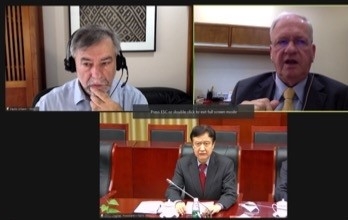

A workshop held by FAPESP and NNSFC featured scientists from China and São Paulo presenting research projects with potential for partnership (clockwise: Paulo Artaxo, Marco Antonio Zago and Li Jinghai; image: screenshot of online event)
A workshop held by FAPESP and NNSFC featured scientists from China and São Paulo presenting research projects with potential for partnership.
A workshop held by FAPESP and NNSFC featured scientists from China and São Paulo presenting research projects with potential for partnership.

A workshop held by FAPESP and NNSFC featured scientists from China and São Paulo presenting research projects with potential for partnership (clockwise: Paulo Artaxo, Marco Antonio Zago and Li Jinghai; image: screenshot of online event)
By André Julião | Agência FAPESP – In the next few years, researchers in China and São Paulo state can investigate together how Brazil and China contribute to climate change and what measures will help mitigate its impact. This is one of the promised outcomes of a workshop held in November 2021 to discuss “China-São Paulo Synergy in Climate Change Research” under the aegis of an agreement signed in 2019 between FAPESP and the National Natural Science Foundation of China (NNSFC).
“Brazil and China are two of the largest countries in the world. Our areas combined correspond to 12% of the planet’s total land area. They are located on almost opposite sides of the globe. Together, they contribute significantly to global climate regulation,” Marco Antonio Zago, President of FAPESP, said in his opening remarks.
The online workshop was chaired by Paulo Artaxo, a professor at the University of São Paulo’s Physics Institute (IF-USP) and a member of the steering committee for the FAPESP Research Program on Global Climate Change (RPGCC).
“To achieve our climate goals we’ll need a lot of innovative research, which can be mutually beneficial if done in collaboration with partners,” Artaxo said.
Luiz Eugênio Mello, FAPESP’s Scientific Director, explained that the workshop was the first of a series of planned events to intensify cooperation among researchers in São Paulo and China.
“The idea is to facilitate collaboration by researchers in the field of climate change, as a result of which we expect a number of exploratory projects to unfold in the next four years. After that, we hope to be able to embark on long-term projects, and lastly to build an alliance in funding that can persist for a long time,” Mello said.
Brazil and China already collaborate very actively, added NNSFC President Li Jinghai. The areas in which there are opportunities for cooperation include energy, agriculture, industry, and biodiversity.
“The scientific leadership provided by NNSFC and FAPESP in their respective countries is informed by a shared interest in achieving the United Nations Sustainable Development Goals [SDGs],” he said.
“In 2015, when the SDGs were launched, China, including NNSFC, considered the UN 2030 Agenda a milestone in progress toward the objectives of cooperation and development for humanity. We all agreed that science and technology were key to achieving the SDGs and mitigating the negative impact of climate change,” said Liyao Zou, Director General of NNSFC’s Bureau of International Cooperation.
Climate change in practice
Research projects were presented during the two-day event on two overarching themes: adaptive management and response of ecosystems to climate change; and the impact of climate change on coastal environments, agri-forestry systems and human health.
Denise Helena Silva Duarte, a professor at the University of São Paulo’s School of Architecture and Urbanism (FAU-USP), talked about several projects she and her group have conducted in the last ten years to evaluate different ways of mitigating climate change in urban environments.
One of the projects used remote sensing, microclimate measurements and numerical simulations to survey plant cover and urban morphology in metropolitan São Paulo. The results were made available to contribute to public policymaking.
“We produced a portrait of the São Paulo metropolitan area, highlighting the ways in which urban morphology and suppression of plant cover affect land surface temperature during the day,” she said.
Shaoqiang Wang, from the Institute of Geographic Sciences and Natural Resources, focused on the role of climate change in natural disasters such as floods in China and drought in Brazil, highlighting the importance of the Amazon Rainforest and Yangtze River Basin as ecosystems under pressure and contributors to global climate regulation.
“Climate change and natural disasters influence ecosystem functions and security to a significant extent, deserving attention for this reason,” he said.
Marcos Buckeridge, a plant biologist and professor at the University of São Paulo’s Institute of Biosciences (IB-USP), spoke about groundbreaking studies by his group on how Brazilian plants, both cultivated and wild, respond to rising levels of atmospheric CO2. In their most recent work, they have measured responses to combinations of greenhouse gases, water stress and rising temperatures.
“We’re currently analyzing thousands of genes for use in transforming plants and developing new varieties,” he said on the second day of the event. “In fact, we already have a new variety [of sugarcane] that grows faster in the lab and produces more sugar. We’re trying to understand what happens with these genes to lead to these results.”
According to NNSFC President Li Jinghai, “We’re all well aware of the climate crisis, and at the same time, we’re facing a scientific paradigm shift. Climate change is a global challenge. No country will be immune to its impact.”
The list of speakers is at: fapesp.br/15189.
Republish
The Agency FAPESP licenses news via Creative Commons (CC-BY-NC-ND) so that they can be republished free of charge and in a simple way by other digital or printed vehicles. Agência FAPESP must be credited as the source of the content being republished and the name of the reporter (if any) must be attributed. Using the HMTL button below allows compliance with these rules, detailed in Digital Republishing Policy FAPESP.





